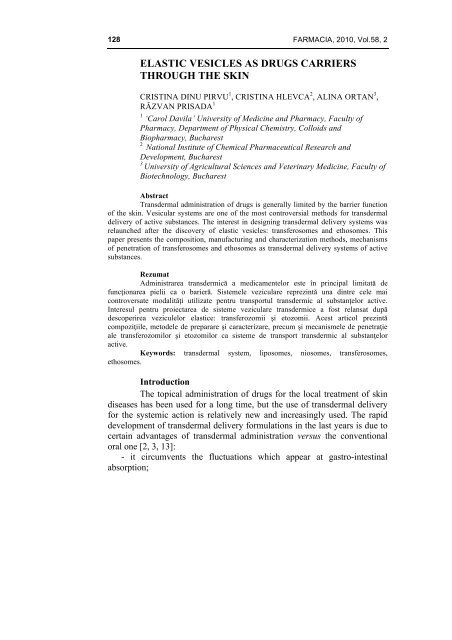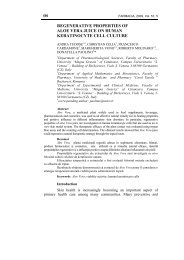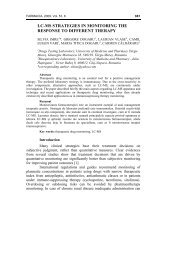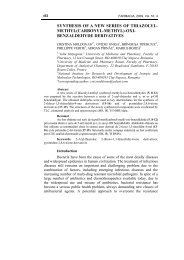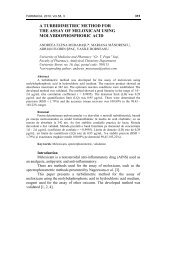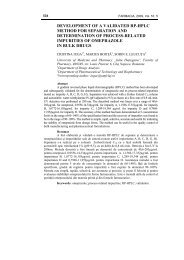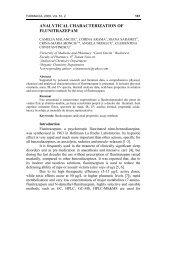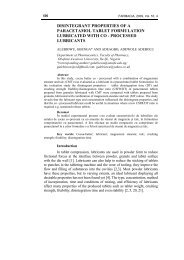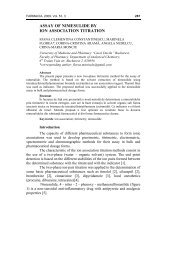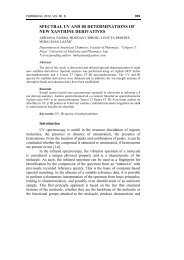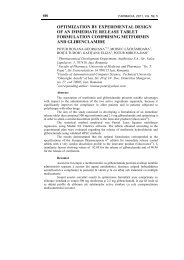elastic vesicles as drugs carriers through the skin - farmacia
elastic vesicles as drugs carriers through the skin - farmacia
elastic vesicles as drugs carriers through the skin - farmacia
Create successful ePaper yourself
Turn your PDF publications into a flip-book with our unique Google optimized e-Paper software.
128<br />
FARMACIA, 2010, Vol.58, 2<br />
ELASTIC VESICLES AS DRUGS CARRIERS<br />
THROUGH THE SKIN<br />
CRISTINA DINU PIRVU 1 , CRISTINA HLEVCA 2 , ALINA ORTAN 3 ,<br />
RĂZVAN PRISADA 1<br />
1 ‘Carol Davila’ University of Medicine and Pharmacy, Faculty of<br />
Pharmacy, Department of Physical Chemistry, Colloids and<br />
Biopharmacy, Bucharest<br />
2<br />
National Institute of Chemical Pharmaceutical Research and<br />
Development, Bucharest<br />
3<br />
University of Agricultural Sciences and Veterinary Medicine, Faculty of<br />
Biotechnology, Bucharest<br />
Abstract<br />
Transdermal administration of <strong>drugs</strong> is generally limited by <strong>the</strong> barrier function<br />
of <strong>the</strong> <strong>skin</strong>. Vesicular systems are one of <strong>the</strong> most controversial methods for transdermal<br />
delivery of active substances. The interest in designing transdermal delivery systems w<strong>as</strong><br />
relaunched after <strong>the</strong> discovery of <strong>el<strong>as</strong>tic</strong> <strong>vesicles</strong>: transferosomes and ethosomes. This<br />
paper presents <strong>the</strong> composition, manufacturing and characterization methods, mechanisms<br />
of penetration of transferosomes and ethosomes <strong>as</strong> transdermal delivery systems of active<br />
substances.<br />
Rezumat<br />
Administrarea transdermică a medicamentelor este în principal limitată de<br />
funcţionarea pielii ca o barieră. Sistemele veziculare reprezintă una dintre cele mai<br />
controversate modalităţi utilizate pentru transportul transdermic al substanţelor active.<br />
Interesul pentru proiectarea de sisteme veziculare transdermice a fost relansat după<br />
descoperirea veziculelor <strong>el<strong>as</strong>tic</strong>e: transferozomii şi etozomii. Acest articol prezintă<br />
compoziţiile, metodele de preparare şi caracterizare, precum şi mecanismele de penetraţie<br />
ale transferozomilor şi etozomilor ca sisteme de transport transdermic al substanţelor<br />
active.<br />
Keywords: transdermal system, liposomes, niosomes, transferosomes,<br />
ethosomes.<br />
Introduction<br />
The topical administration of <strong>drugs</strong> for <strong>the</strong> local treatment of <strong>skin</strong><br />
dise<strong>as</strong>es h<strong>as</strong> been used for a long time, but <strong>the</strong> use of transdermal delivery<br />
for <strong>the</strong> systemic action is relatively new and incre<strong>as</strong>ingly used. The rapid<br />
development of transdermal delivery formulations in <strong>the</strong> l<strong>as</strong>t years is due to<br />
certain advantages of transdermal administration versus <strong>the</strong> conventional<br />
oral one [2, 3, 13]:<br />
- it circumvents <strong>the</strong> fluctuations which appear at g<strong>as</strong>tro-intestinal<br />
absorption;
FARMACIA, 2010, Vol.58, 2 129<br />
- it incre<strong>as</strong>es <strong>the</strong> bioavailability of <strong>drugs</strong> because using <strong>the</strong><br />
transdermal delivery <strong>the</strong> active principle p<strong>as</strong>ses directly into <strong>the</strong><br />
circulatory system, byp<strong>as</strong>sing <strong>the</strong> hepatic metabolism;<br />
- it can give a constant, controlled drug input decre<strong>as</strong>ing <strong>the</strong> variations<br />
in drug pl<strong>as</strong>ma levels;<br />
- it incre<strong>as</strong>es <strong>the</strong> patient compliance by providing a simplified way of<br />
administration, minimum risk of trauma or any o<strong>the</strong>r injury of tissue.<br />
In order to design a drug with transdermal administration certain<br />
difficulties must be resolved. The major difficulty is <strong>the</strong> penetration of <strong>skin</strong><br />
that acts <strong>as</strong> a two ways barrier, controlling <strong>the</strong> loss of water, electrolytes and<br />
o<strong>the</strong>r constituents and preventing <strong>the</strong> entrance of medicinal or harmful<br />
substances from <strong>the</strong> external environment. The <strong>skin</strong> is a membranous,<br />
flexible, protecting cover, mainly formed by two major layers: an external,<br />
unv<strong>as</strong>cularized one (epidermis) and an internal, v<strong>as</strong>cularized one (dermis).<br />
The stratum corneum is <strong>the</strong> uppermost layer of <strong>the</strong> <strong>skin</strong>. It represents <strong>the</strong><br />
final state of stratification and consists of a multi-layered (10-25) structure<br />
of keratin-rich corneocytes embedded in a lipid matrix [10, 25]. Its thickness<br />
is around 10 µm in <strong>the</strong> dry state. The perfect barrier properties of <strong>the</strong> <strong>skin</strong><br />
are provided by <strong>the</strong> stratum corneum. In order to incre<strong>as</strong>e <strong>the</strong> permeability<br />
of <strong>the</strong> <strong>skin</strong> for transdermal delivery of <strong>drugs</strong> several p<strong>as</strong>sive <strong>as</strong> well <strong>as</strong><br />
active techniques have been proposed: penetration enhancers, supersaturated<br />
systems, <strong>vesicles</strong>, iontophoresis, electroporation, phonophoresis,<br />
microneedles, jetinjectors, etc. Despite all <strong>the</strong> efforts devoted to penetration<br />
enhancement, only 10 active substances are currently transdermally<br />
administrated. These substances have certain properties, such <strong>as</strong>: low<br />
molecular weight (
130<br />
FARMACIA, 2010, Vol.58, 2<br />
Vesicles are water-filled colloidal particles. The walls of <strong>the</strong>se<br />
capsules consist of amphiphilic molecules (lipids and surfactants) in a<br />
bilayer conformation. In an excess of water <strong>the</strong>se amphiphilic molecules can<br />
form one (unilamellar <strong>vesicles</strong>) or more (multilamellar <strong>vesicles</strong>) concentric<br />
bilayers. Hydrophilic <strong>drugs</strong> can be entrapped into <strong>the</strong> internal aqueous<br />
compartment, where<strong>as</strong> amphiphilic, lipophilic and charged hydrophilic<br />
<strong>drugs</strong> can be <strong>as</strong>sociated with <strong>the</strong> vesicle bilayer by hydrophobic and/or<br />
electrostatic interactions.<br />
Most commonly, <strong>the</strong> <strong>vesicles</strong> are composed of phospholipids or nonionic<br />
surfactants. The re<strong>as</strong>on for using <strong>vesicles</strong> in transdermal drug delivery<br />
is b<strong>as</strong>ed on <strong>the</strong> fact that <strong>the</strong>y act <strong>as</strong> drug <strong>carriers</strong> to deliver entrapped drug<br />
molecules across <strong>the</strong> <strong>skin</strong>, <strong>as</strong> well <strong>as</strong> penetration enhancers because of <strong>the</strong>ir<br />
composition. In addition, <strong>the</strong>se <strong>vesicles</strong> serve <strong>as</strong> a depot for <strong>the</strong> sustained<br />
rele<strong>as</strong>e of active compounds in <strong>the</strong> c<strong>as</strong>e of topical formulations, <strong>as</strong> well <strong>as</strong><br />
rate-limiting membrane barrier for <strong>the</strong> modulation of systemic absorption in<br />
<strong>the</strong> c<strong>as</strong>e of transdermal formulations [14].<br />
Liposomal formulations can be cl<strong>as</strong>sified in two categories: rigid<br />
<strong>vesicles</strong> – liposomes and niosomes – and <strong>el<strong>as</strong>tic</strong> or ultradeformable <strong>vesicles</strong><br />
– transferosomes and ethosomes.<br />
Liposomes<br />
Liposomes are microscopical spherical <strong>vesicles</strong> mainly composed by<br />
one or more lipidic bilayers, separated by aqueous compartments; <strong>the</strong>y<br />
represent <strong>the</strong> most studied nano- and microparticulate systems for<br />
pharmaceutical applications.<br />
Mezei and Gul<strong>as</strong>ekharam reported for <strong>the</strong> first time <strong>the</strong> effectiveness<br />
of <strong>vesicles</strong> for <strong>skin</strong> delivery, suggesting that <strong>the</strong> lipid formulations can<br />
enhance <strong>the</strong> topical rele<strong>as</strong>e of <strong>drugs</strong> [5, 15, 20]. Despite all <strong>the</strong> efforts<br />
devoted by several researchers, it w<strong>as</strong> impossible to formulate a liposomal<br />
compound that permits <strong>the</strong> systemical rele<strong>as</strong>e of an active principle, mainly<br />
because <strong>the</strong> dimension of <strong>the</strong> liposomes does not allow <strong>the</strong>m to penetrate <strong>the</strong><br />
stratum corneum [7, 23, 24].<br />
Niosomes<br />
Niosomes are <strong>vesicles</strong> composed of nonionic surfactants. The<br />
niosomes have been mainly studied because of <strong>the</strong>ir advantages compared<br />
with <strong>the</strong> liposomes: <strong>the</strong>y are quite stable structures and require no special<br />
conditions for preparation and storage, <strong>the</strong>y have no purity problems and <strong>the</strong><br />
manufacturing costs are low [6, 14, 15]. Unfortunately, <strong>the</strong> performed<br />
studies showed that, like liposomes, niosomes are not suitable for
FARMACIA, 2010, Vol.58, 2 131<br />
transdermal delivery, because <strong>the</strong>y cannot reach <strong>the</strong> deeper layers of <strong>the</strong><br />
<strong>skin</strong>, being trapped in <strong>the</strong> superior layers of stratum corneum. To overcome<br />
this problem, <strong>the</strong> carried out researches introduced a novel generation of<br />
vesicular <strong>el<strong>as</strong>tic</strong> systems: transferosomes (ultradeformable <strong>vesicles</strong><br />
consisting of phosphatidylcholine and an edge activator) and ethosomes<br />
(ultradeformable <strong>vesicles</strong> with high alcohol content) [6, 28].<br />
The main advantage of <strong>the</strong>se ultradeformable vesicular systems is<br />
<strong>the</strong> <strong>el<strong>as</strong>tic</strong>ity of <strong>the</strong> bilayer, given by <strong>the</strong> surfactant molecules in <strong>the</strong> c<strong>as</strong>e of<br />
transferosomes and ethanol in <strong>the</strong> c<strong>as</strong>e of ethosomes; this <strong>el<strong>as</strong>tic</strong>ity allows<br />
<strong>the</strong>m to squeeze <strong>through</strong> channels in <strong>the</strong> stratum corneum that are less than<br />
one-tenth <strong>the</strong> diameter of <strong>the</strong> <strong>vesicles</strong>.<br />
Transferosomes<br />
Transferosomes are a special type of liposomes, consisting of<br />
phosphatidylcholine and an edge activator. The concept of transferosomes<br />
w<strong>as</strong> introduced in 1992 by Cevc and coworkers. These vesicular<br />
transferosomes are several orders of magnitude more <strong>el<strong>as</strong>tic</strong> than <strong>the</strong><br />
standard liposomes and thus well suited for <strong>the</strong> <strong>skin</strong> penetration [6, 8].<br />
Composition. From <strong>the</strong> composition point of view, a transferosome<br />
is a self adaptable and optimized mixed lipid aggregate. Transferosomes are<br />
<strong>vesicles</strong> composed by phospholipids <strong>as</strong> <strong>the</strong> main ingredient (soya<br />
phosphatidylcholine, egg phosphatidylcholine, dipalmityl phosphatidylcholine,<br />
etc), 10-25% surfactants for providing flexibility (sodium cholate,<br />
tween 80, span-80), 3-10% alcohol <strong>as</strong> a solvent (ethanol, methanol) and<br />
hydrating medium consisting of saline phosphate buffer (pH 6.5-7).<br />
Manufacturing method. Phospholipids, surfactants and <strong>the</strong> drug are<br />
dissolved in alcohol. The organic solvent is <strong>the</strong>n removed by rotary<br />
evaporation under reduced pressure at 40ºC. Final traces of solvent are<br />
removed under vacuum. The deposited lipid film is hydrated with <strong>the</strong><br />
appropriate buffer by rotation at 60 rpm for 1 hour at room temperature. The<br />
resulting <strong>vesicles</strong> are swollen for 2 hours at room temperature. The<br />
multilamellar lipid <strong>vesicles</strong> (MLV) are <strong>the</strong>n sonicated at room temperature<br />
to get small <strong>vesicles</strong>.<br />
Characterization. Visualization of transferosomes can be<br />
performed using transmission electron microscopy (TEM) and by scanning<br />
electron microscopy (SEM). Particle size and size distribution can be<br />
determined by dynamic light scattering (DLS) and photon correlation<br />
spectroscopy (PCS). The drug entrapment efficiency by transferosomes can<br />
be me<strong>as</strong>ured by <strong>the</strong> ultracentrifugation technique. Vesicle stability can be<br />
determined by <strong>as</strong>sessing <strong>the</strong> size and structure of <strong>the</strong> <strong>vesicles</strong> over time and
132<br />
FARMACIA, 2010, Vol.58, 2<br />
drug content can be quantified by HPLC or spectrophotometric methods. In<br />
vitro drug rele<strong>as</strong>e can be me<strong>as</strong>ured using a diffusion cell or a dialysis<br />
method [16, 29].<br />
Mechanism of penetration. Transferosomes overcome <strong>the</strong> <strong>skin</strong><br />
penetration difficulty by squeezing <strong>the</strong>mselves along <strong>the</strong> intracellular<br />
sealing lipids of stratum corneum. At present, <strong>the</strong> mechanism of enhancing<br />
<strong>the</strong> delivery of active substances in and across <strong>the</strong> <strong>skin</strong> is not very well<br />
known. Two mechanisms of action have been proposed [18 - 21]:<br />
1. Transferosomes act <strong>as</strong> drug vectors, remaining intact after entering <strong>the</strong><br />
<strong>skin</strong><br />
2. Transferosomes act <strong>as</strong> penetration enhancers, disrupting <strong>the</strong> highly<br />
organized intercellular lipids from stratum corneum, and <strong>the</strong>refore<br />
facilitating <strong>the</strong> drug molecules penetration in and across <strong>the</strong> stratum<br />
corneum.<br />
Cevc and coworkers proposed <strong>the</strong> first mechanism, suggesting that<br />
deformable liposomes penetrate <strong>the</strong> stratum corneum because of <strong>the</strong><br />
transdermal hydration gradient, normally existing in <strong>the</strong> <strong>skin</strong>, and <strong>the</strong>n,<br />
crossing <strong>the</strong> epidermis, enter in <strong>the</strong> systemic circulation [6].<br />
The recent studies propose that <strong>the</strong> penetration and permeation of <strong>the</strong><br />
<strong>vesicles</strong> across <strong>the</strong> <strong>skin</strong> are due to <strong>the</strong> combination of <strong>the</strong> two mechanisms.<br />
Depending on <strong>the</strong> nature of <strong>the</strong> active substance (lipophilic or hydrophilic)<br />
and <strong>the</strong> composition of <strong>the</strong> transferosomes, one of <strong>the</strong> two mechanisms<br />
prevails.<br />
Ethosomes<br />
Ethosomes are deformable liposomes with high alcohol content (up<br />
to 45%). It is proposed that <strong>the</strong> alcohol fluidizes <strong>the</strong> ethosomal lipids and<br />
stratum corneum bilayer lipids thus allowing <strong>the</strong> soft, malleable ethosomes<br />
to penetrate [1, 4]. They have been introduced for <strong>the</strong> first time by Touitou<br />
in 1996. The ethanol from ethosomes’ composition plays <strong>the</strong> same role <strong>as</strong><br />
<strong>the</strong> surfactant from <strong>the</strong> transferosomes, namely disorganizing <strong>the</strong> lipid<br />
bilayer, conferring a ten times higher deformability to <strong>the</strong> particles [12, 17].<br />
Composition. Ethosomes are composed mainly of<br />
phosphatidylcholine, high concentration of hydroalcohols or hydroalcohols,<br />
glycols and water [26]. Phosphatidylcholine can be: phosphatidyl soya<br />
phosphatidylcholine, egg phosphatidylcholine, dipalmityl phosphatidyl<br />
choline, hydrogenated phosphatidylcholine. As alcohols, we can use ethanol<br />
or isopropyl alcohol, and <strong>as</strong> poliglicols propylene glycol and transcutol.<br />
Manufacturing methods. The ethosomes can be prepared from<br />
soybean phosphatidylcholine (Phospholipon 90), ethanol, drug and distilled
FARMACIA, 2010, Vol.58, 2 133<br />
water. Phospholipon 90 and <strong>the</strong> drug should be dissolved in ethanol. Water<br />
h<strong>as</strong> to be added in small quantities and <strong>the</strong> preparation mixed by mechanical<br />
stirring under controlled conditions [9, 11, 25, 27].<br />
Characterization. The methods for characterization of <strong>the</strong><br />
ethosomes are <strong>the</strong> same <strong>as</strong> <strong>the</strong> ones for transferosomes [16, 22, 29].<br />
Mechanism of penetration. The mechanism of penetration of <strong>the</strong><br />
ethosomes in and <strong>through</strong> <strong>the</strong> <strong>skin</strong> is not yet completely elucidated. Two<br />
simultaneous mechanisms of action have been proposed: ethanol h<strong>as</strong> a<br />
fluidization effect on <strong>the</strong> ethosomal lipids and ethanol h<strong>as</strong> a fluidization<br />
effect on <strong>the</strong> stratum corneum lipids.<br />
Because of <strong>the</strong> use of ethanol in <strong>the</strong> preparation of <strong>the</strong> ethosomes,<br />
<strong>the</strong> deformability of <strong>the</strong> prepared <strong>vesicles</strong> is incre<strong>as</strong>ing. Besides, <strong>the</strong> high<br />
alcohol content is expected to partially extract <strong>the</strong> stratum corneum lipids.<br />
These processes are responsible for incre<strong>as</strong>ing inter and intracellular<br />
permeability of ethosomes [16, 25]. The ultradeformable <strong>vesicles</strong> can forge<br />
paths in <strong>the</strong> disordered stratum corneum and finally rele<strong>as</strong>e drug in <strong>the</strong><br />
deeper layers of <strong>the</strong> <strong>skin</strong>. Therefore, a path <strong>through</strong> <strong>the</strong> <strong>skin</strong> can be expected<br />
to result, permitting <strong>the</strong> fusion of ethosomes with <strong>the</strong> cells from <strong>the</strong> deepest<br />
<strong>skin</strong> layers [25, 26].<br />
Conclusions<br />
The use of <strong>the</strong> transdermal route h<strong>as</strong> been well established in <strong>the</strong><br />
p<strong>as</strong>t, and, because its inherent advantages, new methods for transdermal<br />
delivery are continuously developed. The introduction of ultradeformable<br />
<strong>vesicles</strong>, transferosomes and ethosomes, w<strong>as</strong> an important step in<br />
relaunching <strong>the</strong> researches regarding <strong>the</strong> use of <strong>vesicles</strong> <strong>as</strong> transdermal drug<br />
delivery systems.<br />
In comparison to o<strong>the</strong>r transdermal delivery systems, <strong>the</strong> use of<br />
<strong>el<strong>as</strong>tic</strong> <strong>vesicles</strong> h<strong>as</strong> certain advantages: <strong>the</strong>y allow enhanced permeation of<br />
drug <strong>through</strong> <strong>skin</strong>; <strong>the</strong>ir composition is safe and <strong>the</strong> components are<br />
approved for pharmaceutical and cosmetic use; <strong>the</strong>y can incre<strong>as</strong>e <strong>the</strong><br />
transdermal flux, prolonging <strong>the</strong> rele<strong>as</strong>e and improving <strong>the</strong> site-specificity<br />
of bioactive molecules; <strong>the</strong>y can accommodate drug molecules with a wide<br />
range of solubility.<br />
Hence, enhanced delivery of bioactive molecules <strong>through</strong> <strong>the</strong> <strong>skin</strong> by<br />
means of an ultradeformable vesicular carrier opens new challenges and<br />
opportunities for <strong>the</strong> development of novel improved <strong>the</strong>rapies.
134<br />
FARMACIA, 2010, Vol.58, 2<br />
Acknowledgements<br />
The authors would like to thank <strong>the</strong> Romanian Ministry of Education –<br />
Projects Management National Center for <strong>the</strong> financial support <strong>through</strong> project<br />
PN2 61024/2007.<br />
References<br />
1. Ainbinder D., Touitou E., Testosterone Ethosomes for Enhanced Transdermal Delivery,<br />
Drug Delivery 2005, 12, 297-303<br />
2. Barry B., Transdermal Drug Delivery, in Pharmaceutics: The Science of Dosage Form<br />
Design, ed. Aulton E. M., Churchill Livingstone, 2002, 499-528<br />
3. Barry B., Breaching <strong>the</strong> <strong>skin</strong>’ barrier to <strong>drugs</strong>, Nature Biotechnology, 2004, 22, 165-167<br />
4. Bend<strong>as</strong> E.R., Tadros M.I., Enhanced Transdermal Delivery of Salbutamol Sulfate via<br />
Ethosomes, AAPS PharmSciTech, 2007, 8(4), 1-15<br />
5. Bhatia A., Kumar R., Tamoxifen in topical liposomes: development, characterization and<br />
in vitro evaluation, J. Pharm. Sci., 2004, 7(2), 252-259<br />
6. Cevc G., Blume G., Lipid <strong>vesicles</strong> penetrate into intact <strong>skin</strong> owing to <strong>the</strong> transdermal<br />
osmotic gradients and hydration force, Biochim Biophys Acta, 1992, 1104, 226–232<br />
7. Ciobanu Anne-Marie, Hirjau M., Hirjau V., Olteanu M., Dudau M., In Vitro And In Vivo<br />
Studies Of Octyl-Methoxicinnamate-Loaded Liposomes For Topical Application –<br />
Farmacia, 2006, 5, 12-24<br />
8. Dubey V., Mishra D., Asthana A., Jain N., Transdermal Delivery of a pineal Hormone:<br />
Melatonin via <strong>el<strong>as</strong>tic</strong> liposomes, Biomaterials, 2006, 27, 3491-3496<br />
9. Elsayed M., Abdallah O., Naggar V., Deformable liposomes and ethosomes: Mechanism<br />
of enhanced <strong>skin</strong> delivery, Int. J. of Pharmaceutics, 2006, 322, 60-66<br />
10. Godin B., Touitou E., Ethosomes: New prospects in transdermal delivery, Ther. Drug<br />
Carriers Systems, 2003, 20, 63-102<br />
11. Godin B.,Touitou E., Mechanism of bacitracin permeation enhancement <strong>through</strong> <strong>the</strong> <strong>skin</strong><br />
and cellular membrane from an ethosomal carrier, J. Control Rele<strong>as</strong>e, 2004, 94, 365-379<br />
12. Godin B., Touitou E., Ethosomes: new prospects in transdermal delivery, Crit Rev. Ther.<br />
Drug Carrier Systems, 2003, 20(63), 102-123<br />
13. Honeywell-Nguyen P. L., Bouwstra J. A., Vesicles <strong>as</strong> a Tool for Transdermal and Dermal<br />
Delivery, Drug discovery Today: Technologies, 2005, 2, 67-74<br />
14. Hofland H.E.J., Bouwstra J.A.,Spies F., Gooris G., Nagelkerke J.F., Interaction of<br />
Liposomes and Niosomes with Human Skin, J. Pharm. Sci., 1994, 83, 1192-1196<br />
15. Jadoul A., Preat V., Electrically-enhanced transdermal delivery of domperidone, Int. J.<br />
Pharm., 1997, 154, 229 – 234<br />
16. Jain S., Mishra D., Kuksal A., Tiwary A., K., Jain N., K., Vesicular approach for drug<br />
delivery into or across <strong>the</strong> <strong>skin</strong>: current status and future prospects, www.Pharmainfo.net.<br />
17. Jain S., Umamaheshwari RB, Bhadra D, Jain N.K., Ethosomes - A novel vesicular carrier<br />
for enhanced transdermal delivery of an anti-HIV agent, Indian J. Pharm. Sci., 2004, 66<br />
(1), 72-81<br />
18. Jain S., Jain P., Transferosomes: a novel vesicular carrier for enhanced transdermal<br />
delivery: development, characterization and performance evaluation, Drug Dev. Ind.<br />
Pharm., 2003, 29, 1013-1026<br />
19. Jain S., Sapre R., Proultraflexible Lipid Vesicles for Effective Transdermal Delivery of<br />
Levonorgestrel, AAPS PharmSciTech, 2005, 6(3), 513-522<br />
20. Mitragotri S., Kost J., Ultr<strong>as</strong>ound-mediated transdermal drug delivery, in Modified<br />
Rele<strong>as</strong>e Drug Delivery Technology, Rathbone J. M., Hadgraft J., Roberts M. S. (eds.),<br />
Marcel Dekker Inc., 2003, 561 – 571.<br />
21. Paul A., Cevc G., Bachhawat B.K., Transdermal immunization with an integral membrane<br />
component, gap junction protein, by means of ultradeformable drug <strong>carriers</strong>,<br />
transferosomes, Vaccine, 1998, 16 (2-3), 188-195
FARMACIA, 2010, Vol.58, 2 135<br />
22. Patel S.S., Mukesh S.P., Natvarlal M.P., Ethosomes: A Promising Tool For Transdermal<br />
Delivery Of Drug, Pharmaceutical Reviews, 2007, 5(2), www.Pharmainfo.net<br />
23. Popovici A. Lipozomii – vectori medicamentosi, Farmacia, 1986, 34 (1), 1-22.<br />
24. Porfire A. S., Pârvu A. E., Daicoviciu D., Leucuţa S.E., Evaluation of Antiinflamatory<br />
Activity of Liposome Encapsulated Superoxide Dismut<strong>as</strong>e in Rats Peritonitis, Farmacia,<br />
2009, 57(4), 412-423.<br />
25. Touitou E., Godin B.,Weiss C., Enhanced Delivery of Drug Into and Across <strong>the</strong> Skin by<br />
Ethosomal Carriers, Drug Develop. Res., 2002, 50, 406-415<br />
26. Touitou E., Godin B., Dayan N., Piliponsky A., Levi-Schaffer F., Weiss C., Intracellular<br />
delivery mediated by an ethosomal carrier, Biomaterials, 2001; 22, 3053-3059<br />
27. Touitou E., Composition of applying active substance to or <strong>through</strong> <strong>the</strong> <strong>skin</strong>, US patent<br />
5716638, 1998.<br />
28. Touitou E., Ethosomes – novel vesicular <strong>carriers</strong> for enhanced delivery: Characterization<br />
and <strong>skin</strong> penetration properties. J. Control Rele<strong>as</strong>e, 2000, 65, 403-418.<br />
29. Touitou E., Godin B., Dayan N., Weiss C., Intracellular Delivery Mediated By An<br />
Ethosomal Carrier, Biomaterials, 2001, 22, 3053-3059<br />
Manuscript received: July 27 th 2009


